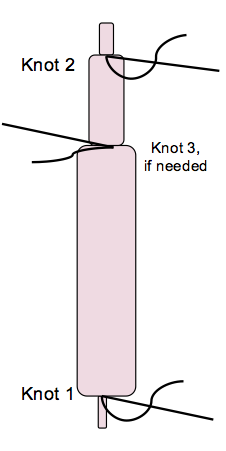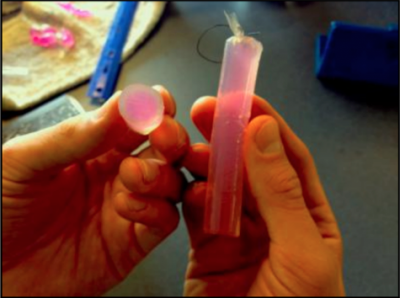This lesson focuses on the diffusion of gas molecules across the cuticle membrane of sea spider legs and the role body size plays in the ability of sea spiders to uptake gases. Students construct model sea spider legs of varying diameters and use them to investigate the relationship between surface area-to-volume ratios and diffusion.
Overview
Molecules are in constant motion and tend to move from regions where they are in higher concentration to regions where they are less concentrated. Diffusion is the net movement of molecules down this “concentration gradient.” Animal metabolism relies on the diffusion of oxygen into cells so that mitochondria can use it in the process of creating energy-carrying molecules that power other cell processes. Oxygen diffusion is a slow process and is an inefficient way to deliver oxygen across large distances. Many animals have evolved specialized structures like gills, lungs, and trachea (in insects) to put oxygen into close proximity to their circulatory systems, which will then deliver it to tissues. With no specialized structures for transporting gases into their body, sea spiders rely on diffusion across their exoskeleton (called a “cuticle”) to power their metabolism. Their bodies are long and skinny and don’t have much space for internal organs, so guts and gonads stretch down through their legs. Though they have a weak heart, they lack a circulatory system (arteries, veins, and other blood vessels) for transporting fluid to much of their bodies. Astoundingly, once the gas has crossed to the inside of the cuticle, sea spiders move oxygen around by squeezing their guts!
This lesson focuses on the diffusion of molecules across the cuticle of sea spider legs and the role that surface area and volume play in the ability of sea spiders to supply their tissues with oxygen molecules. Rather than working with gases dissolved in liquid, you will use vinegar (acetic acid) moving through the cuticles of model sea spider legs of varying diameters made from dialysis tubing and agar gel. A pH indicator solution will allow you to see how far into the spider legs the vinegar has diffused after a set amount of time.
Objectives
Students will be able to:
Explain how diffusion happens using the term “concentration gradient”
Understand the relationship between surface area and volume in solid structures
Qualitatively describe the effects of increasing sea spider size on diffusion of molecules into sea spider legs
Quantitatively graph the relationship between diffusion distance and surface area/volume
Lesson Preparation
Gather and prepare materials for each group of 2-3 students.
Students should have a basic understanding of diffusion, membrane permeability, gas dissolution in liquids, and biological molecules. They should also be familiar with the concepts of solutes, solvents, and concentration.
Engage students in the lesson refreshing knowledge about diffusion. Ask students to engage their prior knowledge to develop explanations for three everyday phenomena: smelling perfume that’s not yours, air fresheners, making tea with a tea bag.
Once students have written or drawn their explanations, I ask students if they notice any similarities between all three events. What I'm looking for is for students to say that either the tea, air freshener, or perfume spreads across space (the room, the mug), reaching the farthest spaces last.
Procedure
Build agar ‘sea spider legs’:
 Knot location for constructing model sea spider leg for diffusion experiment.
Knot location for constructing model sea spider leg for diffusion experiment.
For every 10 legs you wish to make, add 0.8g agar-agar powder to 100 ml of tap water (adjust recipe accordingly for more legs) in a microwave safe bowl or beaker.
Heat mixture in the microwave or on a hot plate until almost boiling. If using a microwave oven, pause oven and stir once a minute while heating. Handle materials only using oven mitts/protective gloves.
While agar is heating, cut 10cm lengths of dialysis tubing and soak in a bowl or beaker of tap water for 5-10 minutes.
Add 10 drops of pH indicator (phenolphthalein) to liquid agar, add more if liquid agar does not turn pale pink color.
Add ammonia to liquid agar drop by drop while stirring until mixture turns and remains vibrant pink.
Rub ends of flattened, soaked dialysis tube between your fingers until the tube opens and sides separate. Insert a stir stick to hold open the tube. Wrap dental floss around one end of the dialysis tubing, remove stir stick, and tie two square knots at the bottom of the tubing to seal the tube (Knot 1 in diagram).
Place tied dialysis tubing into a test tube and insert a funnel into the end of the tube.
Wrap another loop of dental floss around the test tube, preparing a slip knot around the lip.
Slowly pour liquid agar (CAREFUL: HOT) into funnel until the “sea spider leg” inflates and fills the entire tube.
Remove the funnel while pulling the dental floss off the cylinder lip and tightening it around the tube opening. Tie securely with a square knot (knot 2 in diagram).
To compress and fully inflate the agar tube, tie a third knot slightly below the top making a shorter, but more full tube (knot 3 in diagram).
Set the agar-filled tube aside and let the sea spider legs cool until the agar solidifies (~ an hour).
Repeat the procedure with the various sizes of dialysis tubing to create sea spider legs of different diameters.
Experiment with diffusion:
 Model sea spider leg showing extent of vinegar diffusion (clear area) after five minutes.
Model sea spider leg showing extent of vinegar diffusion (clear area) after five minutes.
WAIT ONE HOUR MINIMUM FOR AGAR TO SOLIDIFY
Place each sea spider leg into a tray where it can be submerged in vinegar.
Fill the tray with vinegar until the leg(s) are submerged. If they float, weigh them down with a coin or other negatively buoyant object.
Time exactly FIVE MINUTES. Make predictions about how far the vinegar will diffuse into each diameter leg.
Remove legs from vinegar and cut each one in cross section.
Measure the diameter of the leg and the diameter of the pink area (untouched by vinegar, which lowers the pH and changes the color from pink to colorless).
Calculate how much of the volume of a sea spider leg is reached by diffusing vinegar using this formula: ((diameter of leg/2)2 * 3.14) - ((diameter of pink area/2)2 * 3.14) * length of leg (use 10 cm as a standard size).
Extension
This activity may be extended on several levels. For elementary learners, remove the complications of dialysis tubing and create agar cubes using ice cube trays, then cut to size. Use them to make observations about the surface area/volume relationship in body portions or cells of different shapes and sizes.
For middle school students, place three or four sections of dialysis tubing inside one another before pouring in hot agar to simulate a thicker sea spider cuticle. What happens to the diffusion rates of vinegar when spider legs are the same volume but the cuticle is thicker?
For advanced high school students, build on cuticle thickness comparisons and see how thickness influences rate of diffusion by introducing Fick’s Law of Diffusion.
J = (A/x)D∆C
Fick’s Law takes into account:
Net rate of diffusion (aka “flux”) = J (with units (% vinegar*m^3)/sec)
Surface area = A
Barrier thickness = x
Diffusion coefficient of barrier = D
Concentration gradient of molecules diffusing = (C1 (concentration outside) – C2 (concentration inside)) = ΔC
It’s possible to experimentally determine D for vinegar (acetic acid) passing through dialysis tubing, however, because D is constant, you can use a predetermined value: D=1.0* (〖10〗^(-10) m^2)/sec Concentration gradient ΔC depends on the concentration of vinegar being used (and will always be higher outside the spider leg than inside). A 5% solution of distilled white vinegar outside will have a concentration gradient of 0.05 – 0.0 = 0.5 = ΔC Given these parameters, students will be able to measure the thickness of the dialysis tubing in the experimental spider legs, and calculate the net rate of diffusion for a given surface area.
Resources
Exploratorium https://www.exploratorium.edu/snacks/agar-cell-diffusion
Sea spider science and expedition: http://polargiants.squarespace.com/
Articles on sea spider respiration:
https://www.sciencenewsforstudents.org/article/giant-antarctic-sea-spiders-breathe-really-strangely
http://www.popsci.com/sea-spiders-pump-oxygen-using-their-guts
Guide to necessary knots: http://www.animatedknots.com/reef/index.php
Passive Diffusion Animation: https://www.wisc-online.com/learn/natural-science/life-science/ap1903/the-cell-passive-transport-diffusion
Sea Spider Leg Diffusion Student Data Sheet
Fick’s Law of Diffusion video (12 minutes): https://www.khanacademy.org/science/health-and-medicine/respiratory-system/gas-exchange-jv/v/fick-s-law-of-diffusion
Assessment
Reflection questions are included in the Student Worksheet. Students should discuss their observations and reveal whether or not their predictions matched what they observed. Use formulae on the Student Worksheet to calculate surface area-to-volume ratios and the percentage of each spider leg reached by vinegar in five minutes. Students will graph this relationship and discuss its implications for maximum animal body size.
Author/Credits
This lesson was modified from the lesson “Agar Cell Diffusion,” (Science Snacks Curriculum, The Exploratorium) by Timothy Dwyer (contact: tdwyer [at] springstreet.org) for resources and experiences during the Polar Gigantism in Antarctica 2016 Expedition. Expedition member Steven Lane provided valuable comments on earlier drafts. Additional troubleshooting was provided by Megan Cook, Emma Freedman, Solana Mehl-Zobrist, Aspen Vekved, Sterling Carfrae, and Galen Westervelt. All photos are copyright Timothy R. Dwyer (PolarTREC 2016), courtesy ARCUS.
Standards Other
Next Generation Science Standards
This lesson is specifically designed to target Next Generation Science Standards in Life and Physical Sciences. Life Science standards addressed relate to structure and function. Physical Science standards addressed include investigation of properties of matter, motion of atoms and mixtures. Both sets of Disciplinary Core Ideas relate to the Practice of developing and using models.
2-PS1-4 Matter and Its Interactions
Construct an argument with evidence that some changes caused by heating or cooling can be reversed and some cannot.
4-LS1-1 From Molecules to Organisms: Structures and Processes
Construct an argument that plants and animals have internal and external structures that function to support survival, growth, behavior, and reproduction.
5-PS1-1 Matter and Its Interactions
Develop a model to describe that matter is made of particles too small to be seen.
MS-LS1-2 From Molecules to Organisms: Structures and Processes
Develop and use a model to describe the function of a cell as a whole and ways parts of cells contribute to the function.
HS-LS1-2 From Molecules to Organisms: Structures and Processes
Develop and use a model to illustrate the hierarchical organization of interacting systems that provide specific functions within multicellular organisms.
HS-PS2-6. Motion and Stability: Forces and Interactions
Communicate scientific and technical information about why the molecular-level structure is important in the functioning of designed materials.
| Attachment | Size |
|---|---|
| Full Lesson: Why Do Giant Antarctic Sea Spiders Care About Ratios?618.31 KB | 618.31 KB |
| Student Worksheet81.3 KB | 81.3 KB |
